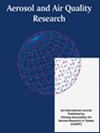“煤改气”政策对华北农村空气VOC水平和臭氧潜能值的影响
IF 2.5
4区 环境科学与生态学
Q3 ENVIRONMENTAL SCIENCES
引用次数: 0
摘要
在2020年和2021年采暖季(HS)期间,在京津冀地区的一个农村地区进行了一项独特的研究,以评估“煤制气”(CTG)对环境挥发性有机化合物(VOCs)的政策影响。同时分析了壁挂式燃气灶空气和烟气中58种挥发性有机化合物。总VOCs从2020年的38.6µg m -3下降到2021年的32.8µg m -3,表明CTG发挥了积极作用。然而,臭氧形成电位(OFPs)从31.5µg m -3增加到44.9µg m -3。甲苯、偏氯乙烯、乙苯、o, m,对二甲苯、4-甲基-2-戊酮、正丁基苯、反式-1,2-二氯乙烯和1,2,4-三甲苯是OFPs的主要贡献者。卤代烃对∑58 VOCs的贡献最大,2020年和2021年分别为54.8%和54.4%。值得注意的是,持续的CTG使WMGS成为最大的VOC来源,在2020年取代煤炭燃烧(CC)。碳排放贡献率从2020年的33.2%下降到2021年的28.7%,而WMGS则从22.5%大幅上升到35.6%。潜在源贡献函数(PSCF)模型表明,WMGS主要来源于局地排放。由于WMGS和先进的低颗粒排放的燃煤炉在供暖模式中占了上风,因此在晴天出现了高VOCs。利用正矩阵分解(PMF)识别因子与WMGS实测剖面的相关系数和散度系数实现WMGS的识别。该研究首次证明了WMGS的使用正在成为中国北方农村VOC的主要来源。与此同时,尽管有了“禁煤法”,农村地区烧煤取暖的现象依然严重。该研究有望为进一步控制挥发性有机化合物和改善农村空气质量提供一些新的策略。本文章由计算机程序翻译,如有差异,请以英文原文为准。
Impacts of the “Coal to Gas” Policy on Rural Air VOC Level and Ozone Potentials in North China
A unique study was enacted during the heating season (HS) in 2020 and 2021 at a rural site in the Beijing-Tianjin-Hebei region to evaluate the policy impacts of “Coal to Gas” (CTG) on ambient volatile organic compounds (VOCs). A total of 58 VOCs in air and flue gas from wall-mounted gas stoves (WMGS) were concurrently analyzed. The total VOCs decreased from 38.6 µ g m –3 in 2020 to 32.8 µ g m –3 in 2021, indicating the CTG played a positive role. However, the ozone formation potentials (OFPs) increased from 31.5 to 44.9 µ g m –3 . Toluene, vinylidene chloride, ethylbenzene, o, m, p-xylene, 4-methyl-2-pentanone, n-butylbenzene, trans-1,2-dichloroethylene, and 1,2,4-trimethylbenzene were the main contributors to the OFPs. Halohydrocarbons contributed the most to ∑ 58 VOCs of 54.8% and 54.4% in 2020 and 2021, respectively. It should be noted that the sustained CTG made WMGS the largest VOC source, replacing coal combustion (CC) in 2020. The CC contributions decreased from 33.2% in 2020 to 28.7% in 2021, while the WMGS far increased from 22.5% to 35.6%. Potential source contribution function (PSCF) modelling showed that the WMGS originated mainly from local emissions. High VOCs appeared surprisingly in clean days, because the WMGS and advanced coal-burning stoves with low particle emission prevailed in heating modes. The recognition of WMGS was achieved by coefficients of correlation and divergence between the positive matrix factorization (PMF) identified factor and field measured profiles of WMGS. This study firstly evidenced that the use of WMGS was becoming a major VOC source in rural north China. Meanwhile, the coal combustion for heating was still serious in rural area despite the “Coal Prohibition” law. The study was expected to provide some novel strategies for further VOC control and air quality improvement in rural area.
求助全文
通过发布文献求助,成功后即可免费获取论文全文。
去求助
来源期刊

Aerosol and Air Quality Research
ENVIRONMENTAL SCIENCES-
CiteScore
8.30
自引率
10.00%
发文量
163
审稿时长
3 months
期刊介绍:
The international journal of Aerosol and Air Quality Research (AAQR) covers all aspects of aerosol science and technology, atmospheric science and air quality related issues. It encompasses a multi-disciplinary field, including:
- Aerosol, air quality, atmospheric chemistry and global change;
- Air toxics (hazardous air pollutants (HAPs), persistent organic pollutants (POPs)) - Sources, control, transport and fate, human exposure;
- Nanoparticle and nanotechnology;
- Sources, combustion, thermal decomposition, emission, properties, behavior, formation, transport, deposition, measurement and analysis;
- Effects on the environments;
- Air quality and human health;
- Bioaerosols;
- Indoor air quality;
- Energy and air pollution;
- Pollution control technologies;
- Invention and improvement of sampling instruments and technologies;
- Optical/radiative properties and remote sensing;
- Carbon dioxide emission, capture, storage and utilization; novel methods for the reduction of carbon dioxide emission;
- Other topics related to aerosol and air quality.
 求助内容:
求助内容: 应助结果提醒方式:
应助结果提醒方式:


